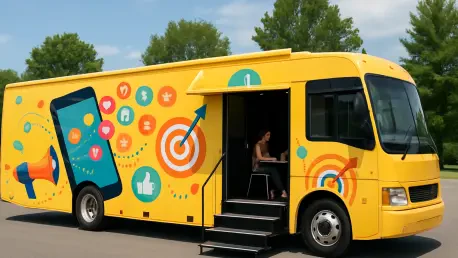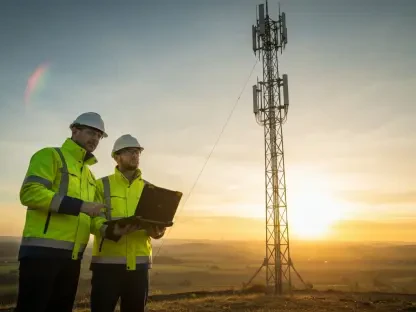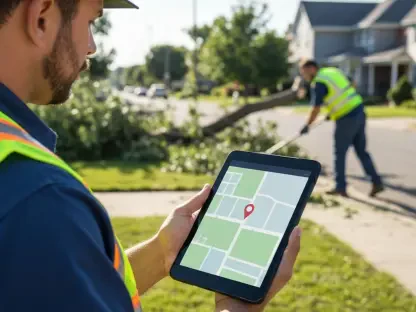Picture a vibrant double-decker bus rolling into a crowded urban square, not to shuttle passengers, but to immerse them in a brand’s unique world with nature-inspired designs and interactive experiences that captivate the senses. Mobile marketing tours have emerged as a dynamic tool for companies across the United States to forge direct connections with consumers, blending the thrill of a road trip with the power of experiential marketing. Brands ranging from skincare giants to outdoor retailers are hitting the highways to engage loyal fans and captivate new audiences through carefully curated, hands-on events. These campaigns are not mere advertisements on wheels; they represent a calculated effort to create lasting impressions. By combining meticulous planning with creative execution, companies aim to stand out in a crowded market. This growing trend taps into the desire for authentic, memorable interactions, setting the stage for a deeper exploration of how such strategies are crafted to maximize impact and build brand loyalty across diverse regions.
The Blueprint Behind Mobile Tours
Strategic Location Selection
Choosing the right destinations forms the backbone of any impactful mobile tour, as brands meticulously analyze data to ensure each stop aligns with their goals. Market research plays a critical role in identifying areas with high pedestrian traffic, favorable demographics, and untapped growth opportunities. Major metropolitan centers like New York and Chicago often top the list due to their dense populations and media exposure, guaranteeing visibility. However, a growing trend sees brands venturing into second-tier markets such as Columbus, Ohio, or Little Rock, Arkansas, where competition is less intense. This approach allows companies to test new territories and connect with audiences who might not encounter the brand otherwise. The balance between established hubs and emerging locales reflects a nuanced strategy aimed at broadening reach while maintaining a strong presence in key areas, ensuring that every stop contributes to overall campaign success.
Beyond the numbers, location selection also hinges on cultural and logistical fit, ensuring the chosen spots resonate with the brand’s identity and message. For instance, a skincare company might target college towns to reach younger demographics, while an outdoor gear retailer could prioritize scenic or revitalized areas that evoke a sense of adventure. Accessibility and local partnerships further influence decisions, as brands seek venues with easy access and collaborate with retailers or event organizers to boost turnout. This careful curation of stops is not random but a deliberate effort to maximize engagement by aligning with consumer lifestyles and local dynamics. Additionally, timing plays a pivotal role, with tours often scheduled around peak seasons or events to capture larger crowds. The result is a roadmap that blends data-driven precision with an intuitive understanding of where a brand’s story will resonate most powerfully, creating a foundation for meaningful interactions.
Data-Driven Route Optimization
The process of mapping out a mobile tour extends beyond picking destinations to optimizing the entire journey for efficiency and impact. Brands leverage advanced analytics to determine the most cost-effective and time-efficient routes, minimizing downtime between stops while ensuring each location receives adequate focus. This involves studying traffic patterns, regional events, and even weather forecasts to avoid disruptions that could dampen attendance or experience quality. Technology aids in real-time adjustments, allowing teams to pivot if unexpected challenges arise. The goal is to maintain a seamless flow that keeps the campaign’s momentum alive, ensuring that every city or town on the itinerary feels like a priority. This level of planning underscores the commitment to delivering consistent, high-quality experiences, regardless of whether the stop is a bustling urban center or a quieter secondary market.
Equally important is the alignment of route planning with marketing objectives, ensuring that each segment of the tour builds on the last to create a cohesive narrative. Brands often sequence stops to gradually increase buzz, starting in high-visibility areas to generate early excitement before moving to less conventional markets to sustain interest. Partnerships with local entities, such as festivals or retailers, are factored into the itinerary to amplify reach at specific points. Digital tools also play a role, with social media analytics helping to gauge interest and adjust plans based on real-time consumer feedback. This strategic orchestration ensures that resources are used effectively, maximizing exposure while keeping operational challenges in check. The result is a well-choreographed journey that not only reaches diverse audiences but also reinforces the brand’s presence through a series of thoughtfully timed and placed engagements.
Designing Experiences That Resonate
Immersive and Emotional Engagement
Central to the success of mobile tours is the ability to craft experiences that leave a lasting emotional imprint on participants, turning fleeting encounters into enduring connections. Brands like St. Ives transform urban spaces into tranquil oases with buses adorned with nature-inspired visuals, promoting relaxation amid city chaos. Similarly, L.L.Bean recreates the nostalgia of outdoor summers through pop-up campsites complete with s’mores-roasting and yard games, evoking a sense of adventure. These setups are meticulously designed to align with the brand’s core values, ensuring that every interaction feels authentic. The focus is on storytelling—whether it’s about unwinding with nature or embracing the great outdoors—allowing consumers to step into a narrative that resonates personally. This emotional hook is what differentiates a mobile tour from traditional advertising, creating memories that linger long after the event concludes.
The power of immersion lies in its ability to engage multiple senses, making the experience more vivid and impactful for attendees across diverse stops. Visual elements, such as themed decorations, draw people in, while tactile activities like product testing or interactive games deepen involvement. Soundscapes, like L.L.Bean’s use of national park audio tracks, add another layer, transporting visitors to different environments. These multi-dimensional setups are tailored to specific demographics, ensuring relevance—think youthful energy for college crowds or family-friendly vibes in suburban areas. Brands also prioritize accessibility, making sure the experience feels inclusive to all who attend. By fostering a sense of belonging or aspiration, these campaigns build a bridge between the consumer and the brand’s ethos, encouraging loyalty through shared values and unforgettable moments that stand out in a world of digital overload.
Blending Physical and Digital Reach
Enhancing the impact of mobile tours, brands integrate digital elements to extend the reach of their in-person events, creating a seamless blend of physical and virtual engagement. Campaigns like St. Ives’ #NatureReset encourage attendees to share their experiences online for a chance to win unique prizes, transforming participants into digital ambassadors. Lush Cosmetics introduces apps for product discovery during their stops, allowing visitors to explore offerings beyond the event itself. This strategy ensures that a single interaction at a tour stop can ripple across social media platforms, reaching audiences far beyond the physical location. The use of hashtags, photo ops, and interactive contests amplifies visibility, making the campaign a shared story that gains traction online. This fusion of real-world and digital touchpoints is a cornerstone of modern marketing, maximizing exposure with minimal additional cost.
Moreover, digital integration allows brands to gather valuable insights and sustain engagement long after the tour moves on to the next city. Analytics from social media shares and app interactions provide real-time feedback on consumer preferences, helping refine future stops or campaigns. Personalized follow-ups, such as targeted emails or exclusive online offers, keep the conversation alive with attendees, nurturing a sense of community. This approach also enables brands to track the campaign’s broader impact, measuring how online buzz correlates with in-person turnout. By weaving technology into the fabric of their tours, companies create a multiplier effect, where a single event sparks ongoing dialogue across multiple channels. The result is a campaign that not only captivates on the ground but also builds a lasting digital footprint, ensuring the brand remains top of mind for both participants and their extended networks.
Building Momentum Through Collaboration and Innovation
Leveraging Collaborative Power
Strategic partnerships with other organizations often elevate mobile tours, adding layers of credibility and drawing larger crowds to each event. L.L.Bean’s collaboration with Uber streamlines logistics for pop-up campsite setups in cities, ensuring smooth execution while tapping into the ride-sharing app’s user base for added visibility. St. Ives aligns with National Geographic to offer a prestigious prize, enhancing the allure of their campaign with an aspirational edge. These alliances are not merely transactional; they are chosen to reinforce the brand’s message, whether it’s a commitment to outdoor exploration or a focus on natural beauty. Such collaborations create a halo effect, where the partner’s reputation boosts trust in the tour’s offerings. The synergy often results in greater media attention and foot traffic, turning a brand activation into a cultural moment that resonates with a wider audience.
Beyond boosting visibility, partnerships also enable brands to offer unique value that might be unattainable on their own, enriching the consumer experience at every stop. Collaborations with local retailers, for instance, provide distribution points or promotional tie-ins that make the tour more accessible to nearby residents. Aligning with well-known entities or causes, such as conservation groups, adds depth to the campaign, appealing to consumers who value purpose-driven initiatives. These joint efforts often lead to cross-promotional opportunities, where both parties benefit from shared audiences and resources. The impact is a more robust campaign that feels like a collective endeavor rather than a solitary brand push. By carefully selecting partners that align with their vision, companies ensure that each collaboration enhances the tour’s narrative, creating a cohesive and compelling experience that stands out in a competitive landscape.
Targeting Diverse Markets
A notable shift in mobile tour strategies involves venturing into less conventional markets, reflecting a keen understanding of the need to diversify geographic reach for maximum impact. Lush Cosmetics’ decision to include Little Rock, Arkansas—a city without an existing store—demonstrates a calculated move to test expansion potential and introduce the brand to fresh audiences. St. Ives targets Columbus, Ohio, capitalizing on a youthful demographic tied to local colleges and bolstered by retailer partnerships. These choices highlight a willingness to experiment beyond saturated urban hubs, seeking spaces where the brand can make a distinct impression. This approach not only mitigates the risk of overexposure in major cities but also uncovers hidden opportunities in areas with less marketing clutter, allowing for deeper engagement with communities that feel uniquely addressed by the campaign.
This focus on diverse markets also serves as a proving ground for long-term growth strategies, offering insights into consumer behavior in varied settings. Brands use these stops to gauge interest and collect data that could inform future store openings or targeted advertising in similar regions. The inclusion of secondary locations often comes with tailored experiences to match local culture or needs, ensuring relevance despite the unconventional setting. For instance, events in smaller cities might emphasize community-building activities to foster a sense of connection. This adaptability showcases a forward-thinking mindset, recognizing that oversaturation in traditional markets can dilute impact. By balancing well-known destinations with emerging ones, brands create a comprehensive footprint that speaks to a broad spectrum of consumers, ultimately strengthening their presence through calculated exploration and localized resonance.
Reflecting on the Road Traveled
Looking back, mobile marketing tours by brands like St. Ives, L.L.Bean, and Lush Cosmetics demonstrated a masterful blend of strategy and creativity in connecting with varied audiences across the U.S. Each campaign carved out memorable moments through immersive setups, from nature-themed escapes to outdoor adventure hubs, leaving a lasting mark on participants. The thoughtful selection of both major cities and unexpected smaller markets showcased an innovative approach to expanding reach. For future endeavors, brands might consider deepening digital integrations to track engagement more precisely or forging even bolder partnerships to enhance authenticity. Exploring untapped regions further could uncover new loyal bases, while refining data tools will sharpen location choices. These steps forward promise to keep mobile tours a vital tactic, ensuring they evolve with consumer expectations and technological advancements for sustained impact.









